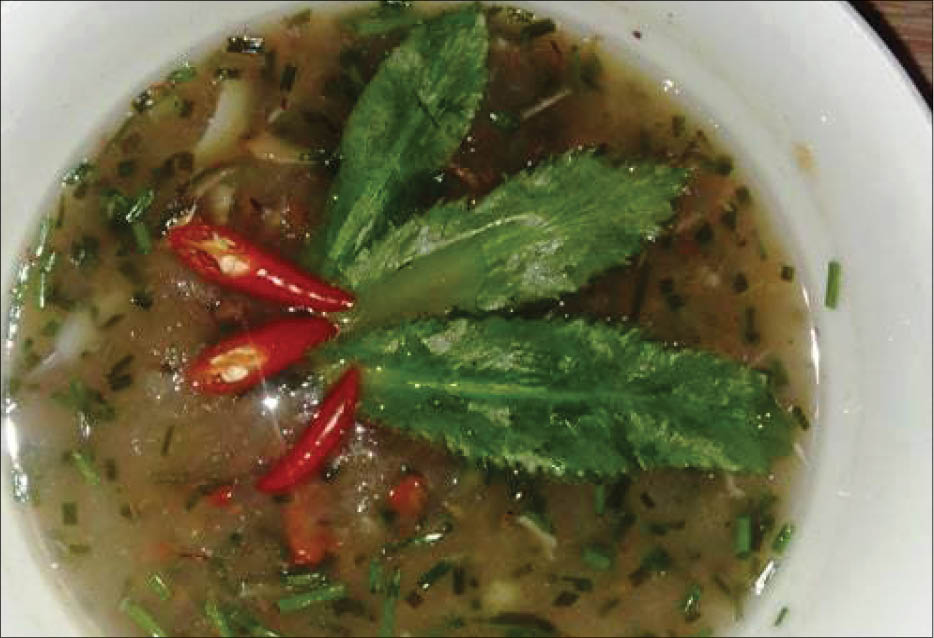
Rustic cassava soup, a strange taste of the highland people
A Luoi district is home to many ethnic minorities. The cuisine of this land is very rich with many dishes listed as specialties, bearing the cultural characteristic of the communities. You can go to A Luoi to enjoy lam rice (rice cooked in bamboo tube), a quat cake, fish lap... but do not forget to enjoy cassava soup, the dish which seems to appear only in the past difficult time. Today, however, it is a delicacy. And for me, cassava soup is like a "symphony" in the middle of the great Truong Son forests.
Why is it so? People say that agricultural products such as stream fish, mountain frogs, and etc., are "tourism ambassadors" for the land of only mountains and forests. Stream fish are caught by the people when passing through the forest. Under the waterfall, the streams are hidden in the wild forest. That is the thousand-year-old culture of the ethnic minorities.
Catching fish from streams, catching frogs and raising wild pigs today are not only the livelihood of the highland people or a means of enriching the daily meals but they are also a mark of the time of nomadism. These foods not only create instant meals but also are reserved by upland residents for the rainy and flooding seasons by smoking them over the kitchen fire.
Now that, many people will wonder what smoked meat and fish have to do with cassava soup? That's what I used to wonder when I was introduced to this dish by my native friend. He said, cassava soup without smoked meat and/or fish has no highland flavor. It is one of the main ingredients of this dish.
When speaking of cassava soup, cassava is an indispensable ingredient. But the cassava used for this dish must be a glutinous variety, which is harvested in the March and April lunar months. This type of agricultural product is grown two seasons in a year by upland farmers. Now, glutinous cassava seems to be grown less, replaced by short-term industrial cassava varieties. To make delicious cassava soup, cassava tubers should be glutinous ones. Choosing the perfect cassava for the dish is not a simple task.
My friend said, the cassava soup of the upland people usually has two types: If it is a liquid soup, it is called a Tưr lục sằn, and if it is a more viscous soup, it is called Pâr ụp sằn. The consistency of the soup is dependent on the taste of each person.
Cooking cassava soup is also a very elaborate process. The cassava is shredded into small strips. Smoked meat or fish should not be too dry, too hard and must have moderate softness. All are washed before processing.
To cook cassava soup, first of all, the smoked fish or meat is torn into strips, or chopped and then stir-fried with basic spices such as salt, chilli, and seasonings ... When stir-frying, we must add the wild pepper to achieve a characteristic aroma. Upland people often do not put oil, shallots or garlic in this dish.
After stir-frying for 5 minutes, add water in. Depending on your preferences, pour the appropriate amount of water. When the water boils, put the cassava in and cook until the cassava turn opalescent white. And, a bowl of cassava soup must also include coriander leaves and scallion from the home garden. "The highland people often prefer to cook cassava soup with meat with a slightly musty smell, exactly the aroma of the forest", my friend informed.
In some other places, young cassava leaf soup cooked with smoked pork has also become a specialty dish. Right in A Luoi highland, it is unknown since when the cassava soup was invented. But once you have tasted the rich flavor of the cassava and the sweet smoked meat and fish blended in the bowl of soup, you will surely not forget about it. It is not only a dish. It is also a process of living as well as the culture of the west land of Thua Thien Hue.
Story and photo: Q. Vien
